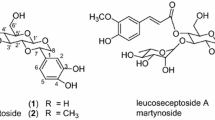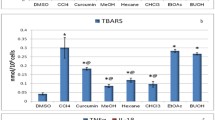Abstract
Through a hepatoprotective bioassay-guided fractionation of the methanol extract from Centaurea pallescens Del. (Asteraceae), a new acylated flavonoid triglycoside, 4′-methoxy kaempferol 3-O-[α-l-rhamnopyranosyl-(1→3)-(2-O-E-p-coumaroyl)] β-d-glucopyranoside-7-O-(4-O-E-p-coumaroyl) α-l-rhamnopyranoside (1) was isolated from the highly active aqueous fraction. In addition, six known compounds were isolated from both aqueous (2–3) and ethyl acetate soluble fractions (4–7). The structure of (1) was determined by comprehensive analysis of 1D and 2D NMR and mass spectral data. The protective effects of the methanol extract of C. pallescens and its fractions on the human hepatoma cell line were evaluated using Silymarin as a positive control. Hepatoprotection was assessed through determination of aspartate aminotransferase (AST), alanine transaminase (ALT), and superoxide dismutase (SOD) activities in addition to glutathione (GSH) levels before and after incubating the cells with carbon tetrachloride. Compound 1, the major constituent of the aqueous fraction, showed a significant cytoprotection at 100 μg/mL as evidenced by decreasing ALT activity to 18.6 ± 0.12, and enhancing SOD activity to 264.6 ± 4.3 U/mL. Meanwhile, compound 2 at 10 μg/mL decreased AST activity to 5.8 ± 2.4 U/mL. Moreover, Compounds 2 and 3 at 1,000 μg/mL significantly enhanced GSH levels. In conclusion, the protective effects of C. pallescens extract, its fractions and compounds 1–3 are concluded to be partly mediated by its antioxidant activity.


Similar content being viewed by others
References
Abdallah HM, Ezzat SM, El Salah, Dine R, Abdel-Sattar E, Abdel-Naim AB (2013) Protective effect of Echinops galalensis against CCl4-induced injury on the human hepatoma cell line (Huh7). Phytochem Lett 6:73–78
Achliya GS, Wadodkar SG, Dorle AK (2004) Evaluation of hepatoprotective effect of Amalkadi Ghrita against carbon tetrachloride induced hepatic damage in rats. J Ethnopharmacol 90:229–232
Al-easa HS, Mann J, Rizk A (1990) Guaianolides from Centaurea sinaica. Phytochemistry 29:1324–1325
Amer MMA, Salama OM, Omar AA (1984) Methylated flavonoidal aglycones from Centaurea alexandrina. Acta Pharm Jugosl 34:257
Amresh G, Rao ChV, Singh PN (2007) Antioxidant activity of Cissampelos pareira on benzo (a) pyrene induced mucosal injury in mice. Nutr Res 27:625–632
Ashok Shenoy K, Somayaji SN, Bairy KL (2001) Hepatoprotective effects of Ginkgo biloba against carbon tetrachloride induced hepatic injury in rats. Indian J Pharmacol 33:260–266
Bishayee A, Sarkar A, Chatterjee M (1995) The hepatoprotective activity of carrot (Daucus carota L) against carbon tetrachloride intoxication in mouse liver. J Ethnopharmacol 47:69–74
Bohm BA, Stuessy TF (2001) Flavonoids of the sunflower family (Asteraceae). Springer, Wien
Castro JA, de Ferreyra GC, de Castro CR, Sesame H, de Fenos OM, Gillette JR (1974) Prevention of carbon tetrachloride induced necrosis by inhibitors of drug metabolism. Further studies on the metabolism of their action. Biochem Pharmacol 23:295–302
Chatterjee TK (2000) Medicinal plants with hepatoprotective properties in herbal opinions, vol vol III. Books and Allied (P) Ltd., Calcutta, p 135
Chattopadhyay RR (2003) Possible mechanism of hepatoprotective activity of Azadirachta indica leaf extract Part II. J Ethnopharmacol 89:217–219
Dianzani MU, Muzia G, Biocca ME, Canuto RA (1991) Lipid peroxidation in fatty liver induced by caffeine in rats. Int J Tissue React 13:79–85
Felice S, Apostolides AN, Maurizio B (2005) Volatile components of Centaurea eryngiodes Lam. and Centaurea iberica Trev. var. hermonis Bois. Lam., two Asteraceae growing wild in Lebanon. Nat Prod Res 19:749–754
Fernández MA, García MD, Sáenz MT (1996) Antibacterial activity of the phenolic acids fractions of Scrophularia frutescens and Scrophularia sambucifolia. J Ethnopharmacol 53:11–14
Harraz FM, Masaouda EA (1988) 1H- and 13C-NMR assignments and cytotoxic activity of the lignan glucoside arctiin from centaurea Alexandrina Del. Alex J Pharm Sci 11:168–171
Hegnauer R (1989) Chemotaxonomie der Pflanzen VIII. Birkhäuser-Verlag, Basel Boston Berlin
Helal HM, Nakamura N, Meselhy MR, El-Fishawy AM, Hattori M, Mahran GH (1998) Guaianolides from Centaurea scoparia. Phytochemistry 45:551–554
Ismail SI, Hammouda FM, Rimpler H, Abdallah SM (1986) Methylated flavonoidal aglycones from Centaurea alexandrina. Planta Med 52:527
Karawya MS, Hilal SH, Hifnawy MS, El-Hawary SS (1975) Phytochemical study of Centaurea calcitrapa L. growing in Egypt. Egypt J Pharm Sci 16:429–444
Mabry TJ, Markham KR, Thomas MB (1970) The systematic identification of flavonoids. Springer, New York
Markham KR, Chari VM (1982) Carbon-13 NMR spectroscopy of flavonoids. In: Harborne JB, Mabry TJ (eds) The flavonoids: advances in research. Chapman and Hall, London
Marklund S, Marklund G (1974) Involvement of the superoxide anion radical in the autoxidation of pyrogallol and a convenient assay for superoxide dismutase. Eur J Biochem 47:469–474
McRae JM, Yang Q, Crawford RJ, Palombo EA (2008) Acylated flavonoid tetraglycoside from Planchonia careya leaves. Phytochem Lett 1:99–102
Mohamed MA, Marzouk MSA, Moharram FA, El-Sayed MM, Baiuomy AR (2005) Phytochemical constituents and hepatoprotective activity of Viburnum tinus. Phytochemistry 66:2780–2786
Mohamed MA, Ahmed WS, El-Said MM, Hayen H (2008) New acylated flavonol diglycosides of Cynanchum acutum leaves. Nat Prod Commun 2:193–198
Muhammed SM (1989) A pharmacognostical study of certain Centaurea species (Centaurea alexandrina, C. pallescens and C. glomerata family; Compositae). M. Sc. Thesis, Alexandria University, Egypt
Ohkawa H, Ohishi N, Yagi K (1979) Assay for lipid peroxides in animal tissues by thiobarbituric acid reaction. Anal Biochem 95:351–358
Recknagel RO (1983) A new direction in the study of carbon tetrachloride hepatotoxicity. Life Sci 33:401–408
Reitman S, Frankel S (1957) A colorimetric method for the determination of serum glutamic oxalacetic and glutamic pyruvic transaminases. Am J Clin Pathol 28:56–63
Subramoniam A, Pushpangadan P (1999) Development of phytomedicine for liver diseases. Indian J Pharmacol 31:166–175
Tackholm V (1974) Student’s flora of Egypt, 2nd edn. Cairo University, Cooperative Printing Company, Beirut, p 413
Thabrew MI, Joice PDTM, Rajatissa WA (1987) Comparative study of efficacy of Paetta indica and Osbeckia octandra in the treatment of liver dysfunction. Planta Med 53:239–241
Torres-Gonzalez L, Munoz-Espinosa LE, Rivas-Estilla AM, Trujillo-Murillo K, Salazar-Aranda R, Waksman De Torres N, Cordero-Perez P (2011) Protective effect of four Mexican plants against CCl4-induced damage on the Huh7 human hepatoma cell line. Ann Hepatol 10:73–79
Wendel A, Feurensteins S, Konz KH (1987) Acute paracetamol intoxication of starved mice leads to lipid peroxidation in vivo. Biochem Pharmacol 28:2051–2053
Youssef DTA (1998) Sesquiterpene lactones of Centaurea scoparia. Phytochemistry 49:1733–1737
Youssef AE, Abdallah OA, Sarg TM, David SJ (1987) Chemical constituents of Centaurea pallescens. Planta Med 53:5
Acknowledgments
The authors are indebted and grateful to Prof. Dr. Olov Sterner and Dr. Karl-Erik Bergquist, faculty of science, Lund university, Sweden, for performing spectral data for all the isolated compounds.
Author information
Authors and Affiliations
Corresponding author
Electronic supplementary material
Below is the link to the electronic supplementary material.
Rights and permissions
About this article
Cite this article
Abdallah, H.M., Mohamed, M.A., Abdou, A.M. et al. Protective effect of Centaurea pallescens Del. against CCl4-induced injury on a human hepatoma cell line (Huh7). Med Chem Res 22, 5700–5706 (2013). https://doi.org/10.1007/s00044-013-0563-y
Received:
Accepted:
Published:
Issue Date:
DOI: https://doi.org/10.1007/s00044-013-0563-y




